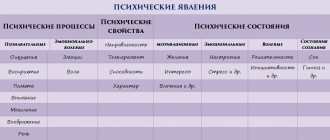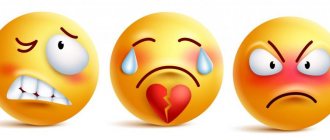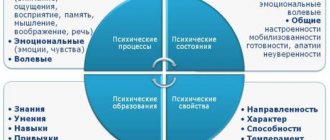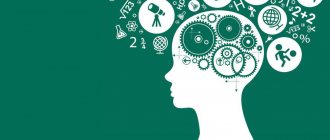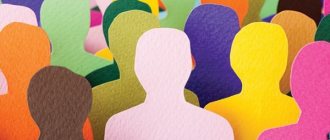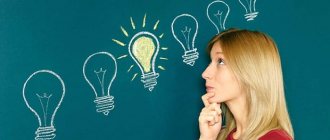Emotional and volitional mental processes
5.1. Emotional Processes
Emotional Process
– the mental process of reflecting in consciousness the subjective meaning of objects and situations (in the form of experiences), influencing the perception, behavior, thinking, motivation, and activity of the individual. Emotional processes are a general term denoting the subjective conscious experience characterized by and associated with the psychophysiological and biological reactions and mental states of the body.
Emotional intellect
(eng. emotional intelligence) - a type of intelligence defined as the ability to correctly and appropriately perceive, evaluate and express emotions, use emotions to facilitate thought processes, understand and analyze emotions, effectively use emotional knowledge, manage your emotions while simultaneously promoting emotional and intellectual development.
Classification of emotional processes
according to their psychological characteristics and patterns of progression:
- affects
(English affect, from Latin affectus - emotional excitement) - short-term intense emotional processes, reflecting a subjective assessment of the situation at an unconscious level, manifested in pronounced motor reactions and changes in the functioning of internal organs and systems of the body; - emotions
(English emotion) – emotional processes reflecting a subjective assessment of the situation at a conscious level
,
which, in comparison with affects, are longer and less intense; - feelings
(English feeling) – a subjective representation of emotions belonging to the individual who experiences them; - moods
are diffuse affective states characterized, in comparison with emotions, by longer duration and lower intensity.
Passion
(English passion, from Greek suffer) is a term used to describe intense emotions, strong feelings and desires. In strength, passion is comparable to affect, and in duration - with feelings.
Physiological basis
emotional processes – restructuring of the internal environment of the body for the purpose of adaptation, carried out under the control of specialized structures of the brain. The leading role in emotional processes is played by the cerebral cortex and the centers of the autonomic nervous system located in the subcortical regions of the brain.
The fibers of the autonomic nervous system mediate the work of smooth muscles and endocrine glands, which synthesize and release hormones into the bloodstream that affect blood pressure, pulse, respiratory rate, blood glucose levels, etc.
In a normal state, the cerebral cortex has an inhibitory effect on the centers of the autonomic nervous system, and external manifestations of emotions and feelings are insignificant. When the cerebral cortex transitions to a state of excessive excitation, the centers of the autonomic nervous system are also overexcited, which leads to vivid emotional manifestations.
Rice.
5.1. Classification of emotional mental processes
Affects
The term affect refers to instinctive reactions to external stimuli that occur before the typical cognitive processes necessary to form more complex emotions. Affect is the most intense form of emotional experience. Most often, strong affect occurs in extreme situations, disrupting the normal functioning of perception and thinking. Affective reactions can occur involuntarily, without intentional perception and cognitive processing.
The reaction to stimuli is dominant in lower organisms and primary for humans. In animals, affects are a defensive reaction and are caused by factors directly related to vital biological needs and instincts. The content and nature of affects are significantly influenced by the social environment and relationships with other people.
Distinctive features of affect:
situational, generalized, short-term, high intensity.
Forms of manifestation of affect:
anger, delight, ecstasy, horror, despair, stupor, constraint.
Emotions
Emotion is a complex pattern of changes involving physiological arousal, feelings, cognitive processes and behavioral reactions in response to situations that are perceived by the subject as personally significant.
Emotions often influence mood, temperament, character, motivation and behavior; they occur under the influence of hormones and neurotransmitters such as dopamine, norepinephrine, serotonin, oxytocin and cortisol. Emotions are often the driving force behind positive/negative motivation and are associated with behavioral trends.
Emotions are mental processes and states associated with the instincts, needs and motives of a person/animal, expressed in the form of experiences. Emotions accompany various manifestations of human activity and are the most important mechanism of internal regulation of human activity and behavior. An important aspect of emotion is cognition, in particular the evaluation and interpretation of events. Basic emotions:
anger, disgust, fear, happiness, sadness and surprise (Paul Ekman, []).
Components
of emotions
:
- impressive –
internal manifestations of emotion (for example, increased breathing and heart rate, increased blood pressure); - expressive
- external manifestations of emotions: undifferentiated muscle reactions (trembling, increased tone) and expressive movements of a communicative signaling nature (facial expressions, gestures, posture, voice intonation).
Emotions are not tied to a specific object and arise in relation to the situation as a whole; they can flow intensely and change quickly. Compared to affects, emotions are much longer in time and weaker in strength; some of them may lack an expressive component.
Emotions can reflect the subjective evaluative attitude of not only real, but also virtual situations. The ideational nature of emotions lies in the ability to arise not only in relation to real ones, but also in relation to expected, imaginary situations and events.
Components of emotions:
- cognitive assessment of events and situations.
- physical symptoms are the physiological component of emotional experience;
- action tendencies – a motivational component for preparing and controlling motor reactions;
- expression - facial expressions and voice accompanying the emotion show the reaction and intentions of the actions;
- feelings are the subjective experience of an experienced emotional state.
Psychological theories of emotions:
- Evolutionary Theory of the Origin of Emotions
, by Charles Darwin, “The Expression of the Emotions in Man and Animals,” 1872. Emotions have evolved through natural selection as vital mechanisms for the organism’s adaptation to the external environment. Physiological changes that accompany emotions are rudiments (residual manifestations) of real adaptive reactions of the body. - Rudimentary theory of emotions
, authors Herbert Spencer (1820 - 1903), Théodule Ribot (1839 - 1916) and others. Emotions are the rudiments of affects that accompanied full-fledged biological reactions of the body. Human emotions are biologically derived from the instinctive and affective reactions of animals. - The Structural Theory of Emotions
by James Papertz (1883 – 1958). There is a single system that unites a number of brain structures and forms the brain substrate for emotions - the limbic system. - James-Lange
somatic theory of emotions , authors William James (1842 – 1910), Carl Georg Lange (1834 – 1900). Emotions are secondary to physiological phenomena. The impact of external stimuli on the body causes physiological changes in it, which leads to the emergence of emotions. - Cannon-Bard theory of emotions
, authors Walter Bradford Cannon (1871 – 1945), Philip Bard (1898 – 1977). Emotions are of a sensory nature: in the process of perception, sensory information enters the thalamus, where it is then redistributed: part of the information is transmitted to the cerebral cortex, giving rise to the subjective experience of emotions, and the other part to the hypothalamus, which regulates all functions of the body. - Lindsay-Hebb activation theory
, authors Donald Olding Hebb (1904 – 1985). Emotions are the sensory equivalent of the brain's activating system, capable of activating the cerebral cortex. The activity of the reticular formation of the brain stem, which filters sensory information and transmits it to the limbic system and cerebral cortex, is correlated with the intensity, duration and quality of emotional experience. - Two-factor theory of emotions
, authors Stanley Schechter (1922 - 1997), Jerome Everett Singer (born 1934). Emotion is a combination of two components: quantitative (physiological arousal) and qualitative (cognitive interpretation of arousal). - Biological Theory of Emotions
, by P.K. Anokhin (1898 – 1974). Emotions are a biological product of evolution that implements the mechanism of adaptation of animals to the environment. Negative emotions are caused by the emergence of needs and play a mobilizing role. Satisfaction of needs generates positive emotions. - Need-information theory of emotions
, author P.V.
Simonov (1926 – 2002). The appearance of emotions is caused by a lack/excess of information necessary to satisfy a need. “ Formula of Emotion
”, proposed by P.V.
Simonov: E = P_(Is - In)
, where
E
is an emotion (strength, quality, sign),
P
is a need,
In
is the information necessary to satisfy it,
Is
is the information that the subject has at the time the need arises. - Cognitive dissonance theory
by Leon Festinger (1919 – 1989).
The emergence of negative emotions is caused by cognitive dissonance
(the discrepancy between the expected and the received result), and positive emotions –
by cognitive consonance
(the coincidence of the expected and the actual). - A unified concept of consciousness and emotions
(Yu. I. Aleksandrov []). Consciousness and emotion should not be viewed as separate psychological processes with different neurophysiological mechanisms. In goal-directed behavior, consciousness and emotions perform similar functions, but with different aspects and at different levels. Behavior is both emotional and conscious.
Functions of emotions:
- o reflective-evaluative
– allows you to generally reflect and evaluate the situation at a conscious level; - signaling
- psychophysiological and biological reactions signal the need to mobilize and adapt the body to the external environment; - reinforcing
– emotions contribute to the development of conditioned reflexes and more durable memory; - communicative
– emotional response, including syntony (emotional “consonance”), as well as microexpressions that accompany emotions and are not amenable to conscious control, help improve mutual understanding between participants in a communicative act; - control
– emotions act as a mechanism for internal regulation of activity and behavior; - mobilizing
– physiological changes that accompany emotions mobilize the body in extreme situations; emotions are the stimulants (motives) of an individual’s activity and behavior; - compensatory
- emotions allow you to compensate for the shortcomings of other mental phenomena.
Classification of types of emotions
- Based on the nature of the needs underlying emotions, the following types of emotions are distinguished:
- lower
- emotions associated with the satisfaction of natural (organic) needs (for oxygen, water, food, etc.), inherent in both animals and humans;
higher
– socially conditioned emotions associated with the satisfaction of needs for security, belonging and love, respect, cognitive, aesthetic needs, needs for self-realization and transcendental needs; are unique to humans. - lower
- By valence
(
I'm drowning
) emotions can be
positive
(joy, interest) or
negative
(fear, anger, rage). It is interesting that in humans the number of negative emotions is several times greater than the number of positive ones.Ambivalence
– simultaneous experience of emotions of opposite signs.
- Based on intensity
(
strength
),
strong
and
weak
emotions are distinguished; The stronger the emotion, the more pronounced its impressive and expressive components will be. - By influence on activity
There are different types of emotions:- sthenic
(from ancient Greek strength) - increase the vital activity of the body, mobilize, encourage active activity (joy, enthusiasm, delight, etc.);
asthenic
(from ancient Greek impotence) - oppress, suppress vital processes in the body (horror, sadness, melancholy, depression, etc.). - sthenic
Emotional disorders
The following pathologies of the emotional sphere of personality are distinguished:
- affective excitability
- a tendency to too easily experience strong emotional experiences that do not correspond to the situation that caused them; - affective weakness
– excessive emotional sensitivity to all external stimuli; anger is a type of affective weakness; - affective lethargy
– rigidity, inertia of emotional reactions, combined with a tendency to fixate on negative experiences; may be accompanied by excessive touchiness, pathological resentment; - affective exhaustion is
the short duration of vivid emotional manifestations, which are then replaced by weakness and indifference.
Origin of emotions
Among the most necessary reactions of the body are:
- instincts,
- motives,
- reflexes,
- emotions.
According to some theories, our ancestors initially existed using the first two. Motives indicated which direction to move. For example, if a man wanted to eat, he went hunting. Instincts and reflexes made it possible to obtain food and build monasteries. But there was a clear problem. It was difficult for an individual to educate his offspring without an emotional connection. This took too much time. It was difficult for the mother to understand why the baby was whining. And he, in turn, did not fully understand who was in front of him and what to expect from this person. And although an emotional connection does not arise in a matter of seconds, the stronger it becomes, the more understanding comes.
Thus, based on modern research data, we can assume that the origin of emotions is connected precisely with this. In addition, it was very difficult for our ancestors to communicate with each other. Conversation without emotional support sometimes raised more questions than answers.
Emotions
These mental processes are less intense, but longer lasting. Like many other mental phenomena, they are not fully understood. Various scientists see these processes in their own way and classify them. But in general terms, even without special knowledge in the field of psychology, the following types can be distinguished:
- positive;
- negative;
- neutral;
- static;
- dynamic.
Considering emotions from a physiological point of view, we can conclude that this is a state of brain structures that prompts a change in behavior towards minimizing or maximizing its manifestations. In other words, these processes adapt the body to its environment. For example, if a person experiences an emotion such as fear, the body begins to prepare for “avoidance behavior.” At this time, the work of the sense organs intensifies, muscles tense, and adrenaline is released.
Scientists have also found that each emotion has its own characteristic involuntary facial signs. For example, when a person regrets something, the corners of his lips move down. And when, on the contrary, he is happy, he smiles. Moreover, there is facial feedback. Arbitrary movements of the lips and eyebrows can evoke one or another emotion. That's why scientists advise smiling as often as possible. After all, this can “call” the following emotions into your life:
- joy,
- happiness,
- pleasure.
In turn, according to some theories, being in a state of euphoria can bring many good events to life.
Everything in the world is painted black and white. Everything cannot always be bright and joyful. Negative emotions occupy the same place in people's lives as positive ones. And even if a person is cheerful, he also has manifestations of resentment and sadness, although perhaps this is not particularly noticeable to others. But the less negative emotions you experience, the better your mood will be.
Moods
This type of emotion is considered to be the longest lasting. Although in fact, a change in a person’s psycho-emotional state can occur very sharply and several times a day. Mood is also understood as the impression of a movie seen or a melody heard. This type of process can also mean aspirations, attitudes, desires. Mood determines the general line of a person's life. Unlike affects, it is very easy to hide.
On the other hand, if emotions, for example, are a response to certain events, then the etiology of the mood cannot always be understood. Sometimes a person is just sad. And he doesn’t know the reason why this happens. Prolonged bad mood often leads to depression. Often this process is influenced by the physiological state. For example, when a person is in pain, he is in a bad mood. Fatigue and disturbances in the functioning of the endocrine system can also affect.
Main classification
The human body is complex and multifaceted. And the most difficult area to study is still the brain and the processes that occur in it. The difficulty lies in the fact that for each person they are of a purely individual nature. It is difficult to find two people with identical manifestations of all processes. To a greater extent, differences are influenced by both genetic characteristics and the society in which the individual grows. Thus, in psychology the following types of mental processes are known:
- educational,
- strong-willed,
- emotional.
It is the latter that will be the subject of our study.
Throughout our lives, we encounter various manifestations of emotional processes: joy, fear, anxiety, anger, irritation, etc. Most often, we don’t even think about why this happens. Or rather, we subconsciously know the reason, but we don’t quite understand what processes in our body control emotions. Moreover, some of them we cannot control at all.
But before we look at what types mental emotional processes are divided into, it should be noted that different researchers classify them differently. In general, there are 4 types:
- Affects.
- Emotions.
- Feelings.
- Moods.
How are they different?
